Delicious and filling, this Vegan Salmon is easy to make in two different ways: bake it for an easy, hands-off meal or pan sear it and enjoy a crispy “skin” on top with a moist and flaky interior that will impress everyone.
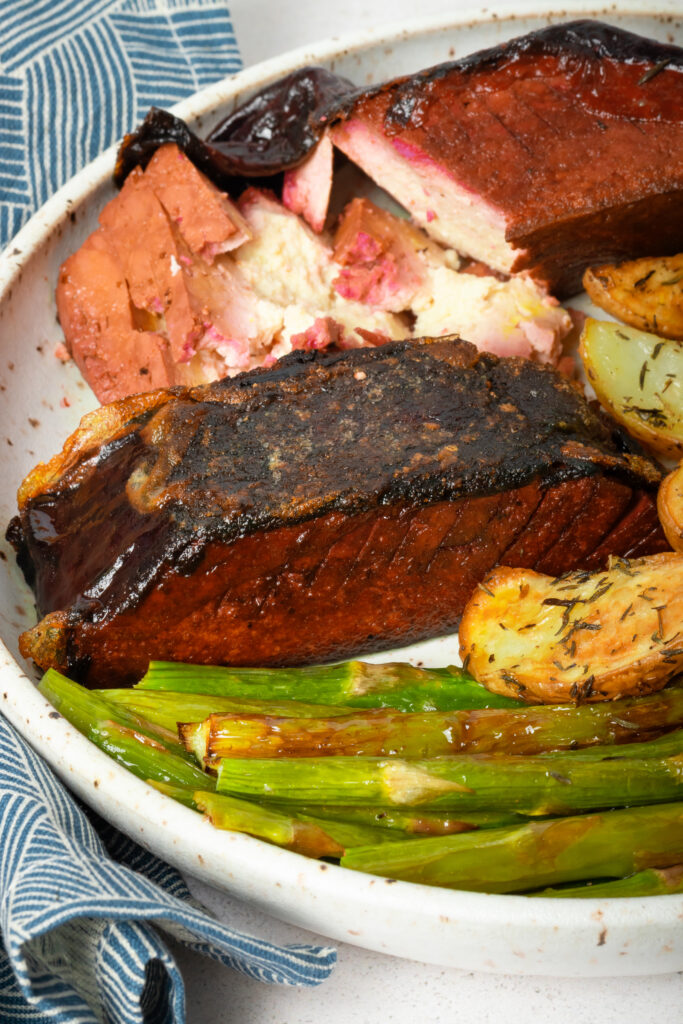
This post may contain affiliate links. See our disclosure policy for details.
Hey Internet, I’ve been experimenting with tofu since going vegan back at the end of 2017 but I’ve never done anything like this before. I present to you: Vegan Salmon!
Perhaps a more specific term would be tofu salmon, as this dish is made by marinating a shaped super firm tofu “filet” and then pan searing or baking it for an exciting presentation.
Is it the perfect color? No. I was more focused on getting the PERFECT flavor and texture.
Is it fishy? It’s slightly “fishy” but not grossly so. Before I went vegan, I was weird about fish--I only liked very mild fish like baked salmon, tilapia, etc.
But this vegan fish, no matter how you cook it, has a savory and delicate flavor, but it’s also completely satisfying and protein-packed.
It is so unbelievably easy to make, and doesn’t require any special tools. The leftovers are GREAT for lunch the next day, too.
This star of the show goes perfectly with my vegan roasted potatoes and some roasted asparagus, green beans, broccoli, or even brussels sprouts. Check out this tutorial on how to air fry frozen brussels sprouts (or fresh!) if you’re interested.
As for other ways to serve this “salmon” - you could serve it on top of a salad, broken up into pasta (or just alongside), as the protein in my vegan paella, or you could even use it to make “fish cakes” which believe me, I’ll be trying next!
My mom used to make the best poached salmon with lemon and dill, so I definitely also want to try that. I’m also thinking of making some baked vegan salmon with my homemade vegan honey and lots of garlic, though I think agave and garlic would work too.
Alright, enough raving, let’s talk about ingredients.
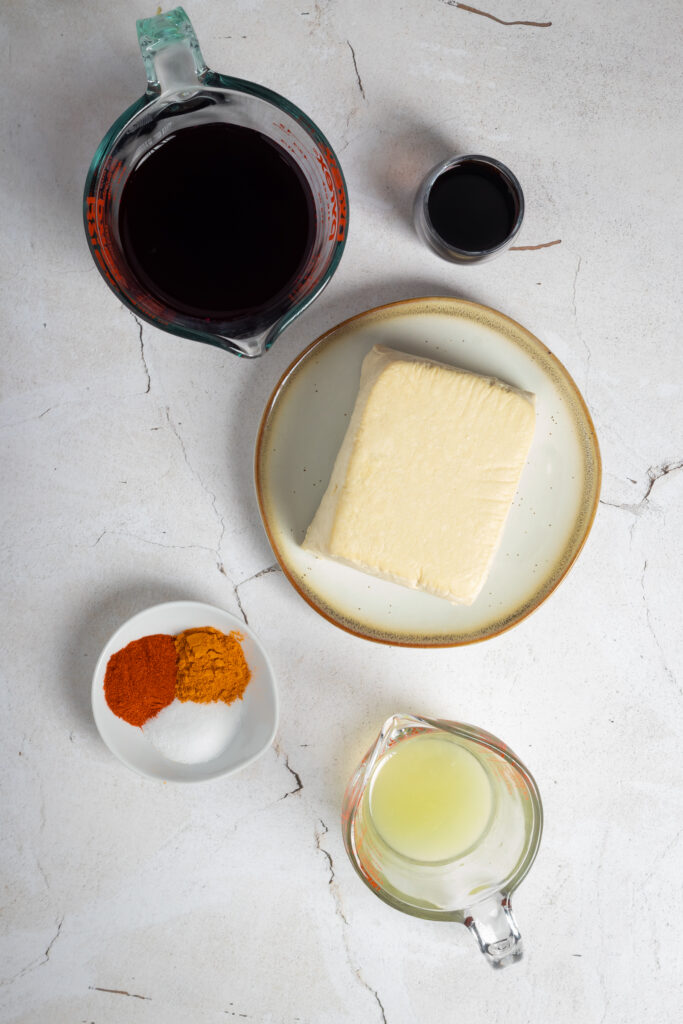
What You’ll Need
- Beet juice: Don’t worry if you don’t like beets! I hate them and I couldn’t even taste them in this recipe. I do feel like the beet juice does help a bit with the flavor of the vegan salmon, but the main purpose of it is to color the tofu--and it does kind of make the salmon neon pink, yeah. If you can’t find beet juice, you could try unsweetened pomegranate juice, or simply use vegetable broth if you don’t care about the color. You could also try vegan food coloring. You can experiment with watering down the marinade to lighten the salmon, but when I tried it, the flavor wasn’t as delicious so I left it vibrant albeit unrealistic in appearance.
- Lemon juice: Fresh lemon juice is best for this. The more you add, the more tangy and “fishy” your tofu will be.
- Reduced sodium soy sauce: This adds a nice flavor. If you can’t have gluten, try using gluten-free tamari instead.
- Spices: I used ground turmeric, smoked paprika, and iodized kosher salt. I recommend a finer grain salt like iodized salt in this recipe because we want it to dissolve quickly and evenly in the marinade.
- Tofu: The star of this dish is tofu. Making tofu salmon is super easy as long as you have the right type of tofu. My number one tip is to use “super firm tofu,” or tofu that comes in a vacuum sealed pack (as opposed to tofu that comes submerged in a plastic tub of water). IF all you can get your hands on is extra firm or regular firm tofu in a tub of water, you’ll want to press the tofu for around 30-40 minutes in a tofu press or wrapped in paper towels between two cutting boards or plates and a heavy weight. If you have to buy tofu like that and press it, you may only be able to get one “filet” out of each block since pressing it does make the block thinner.
- Optional: Nori Sheets and Rice Paper Spring Roll Wrappers: This is only if you want to add a “skin” to the top of your tofu, which I only recommend if you’re pan searing it. I tried to do it for the baking method and it didn’t wow me but of course you’re welcome to try.
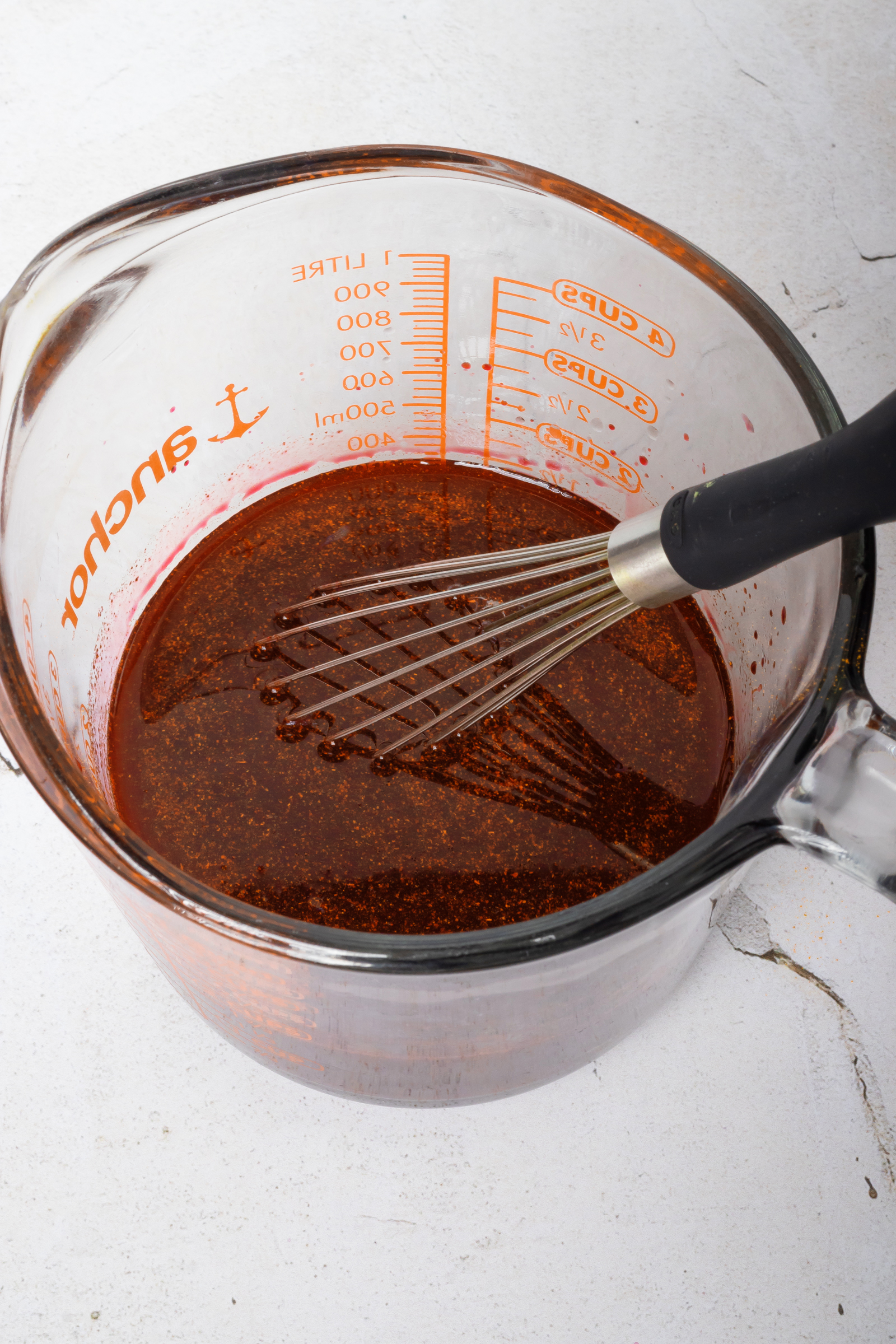
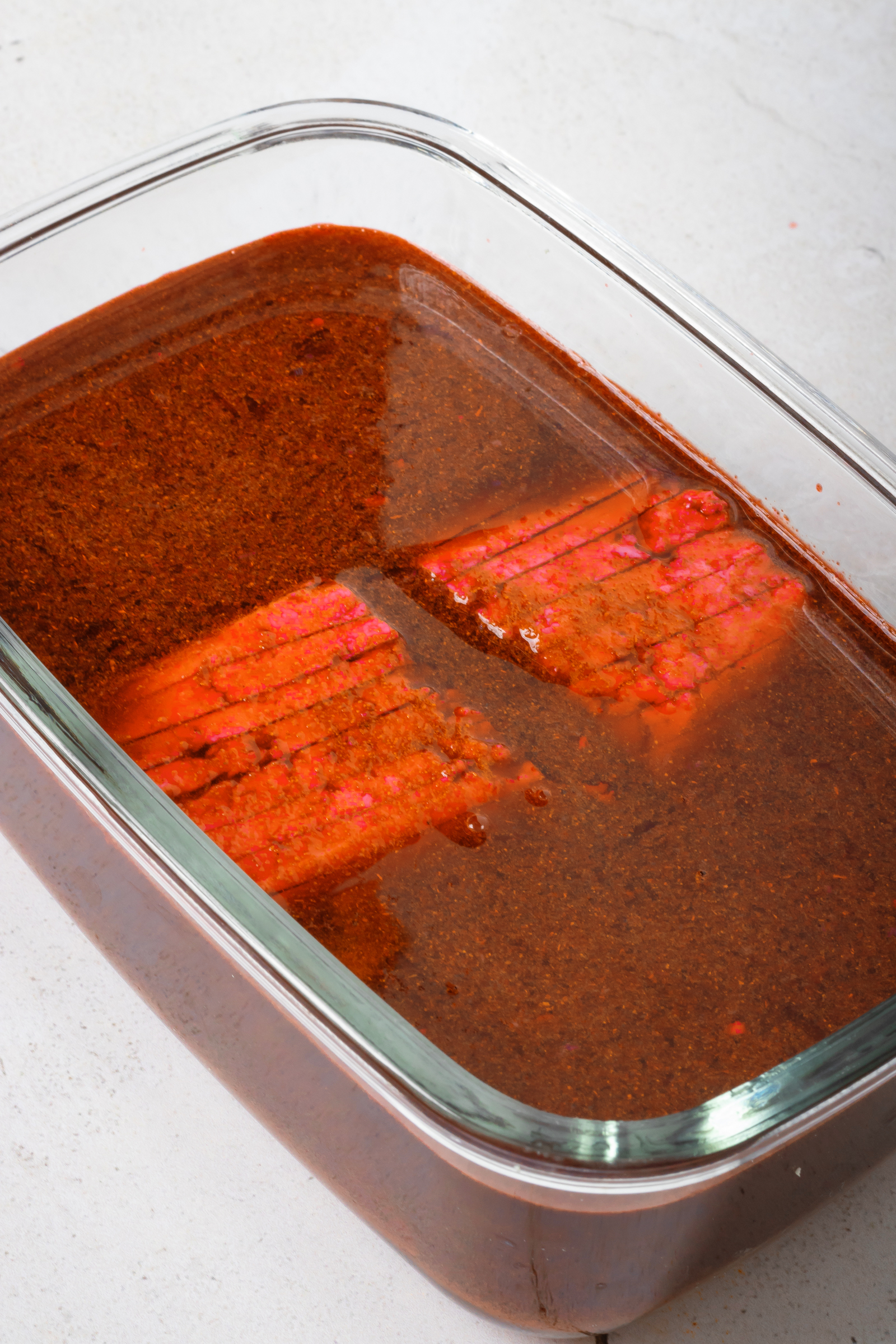
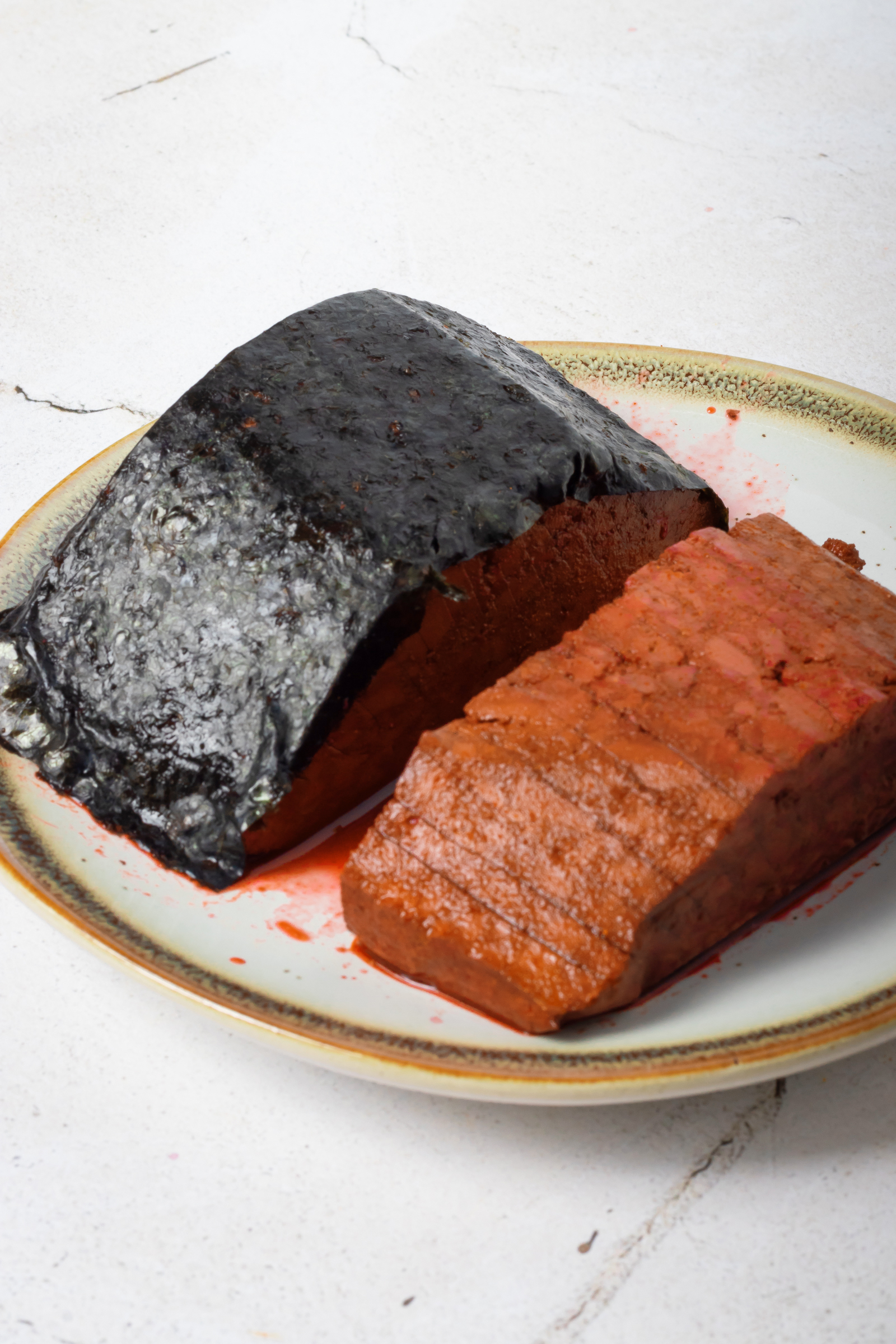
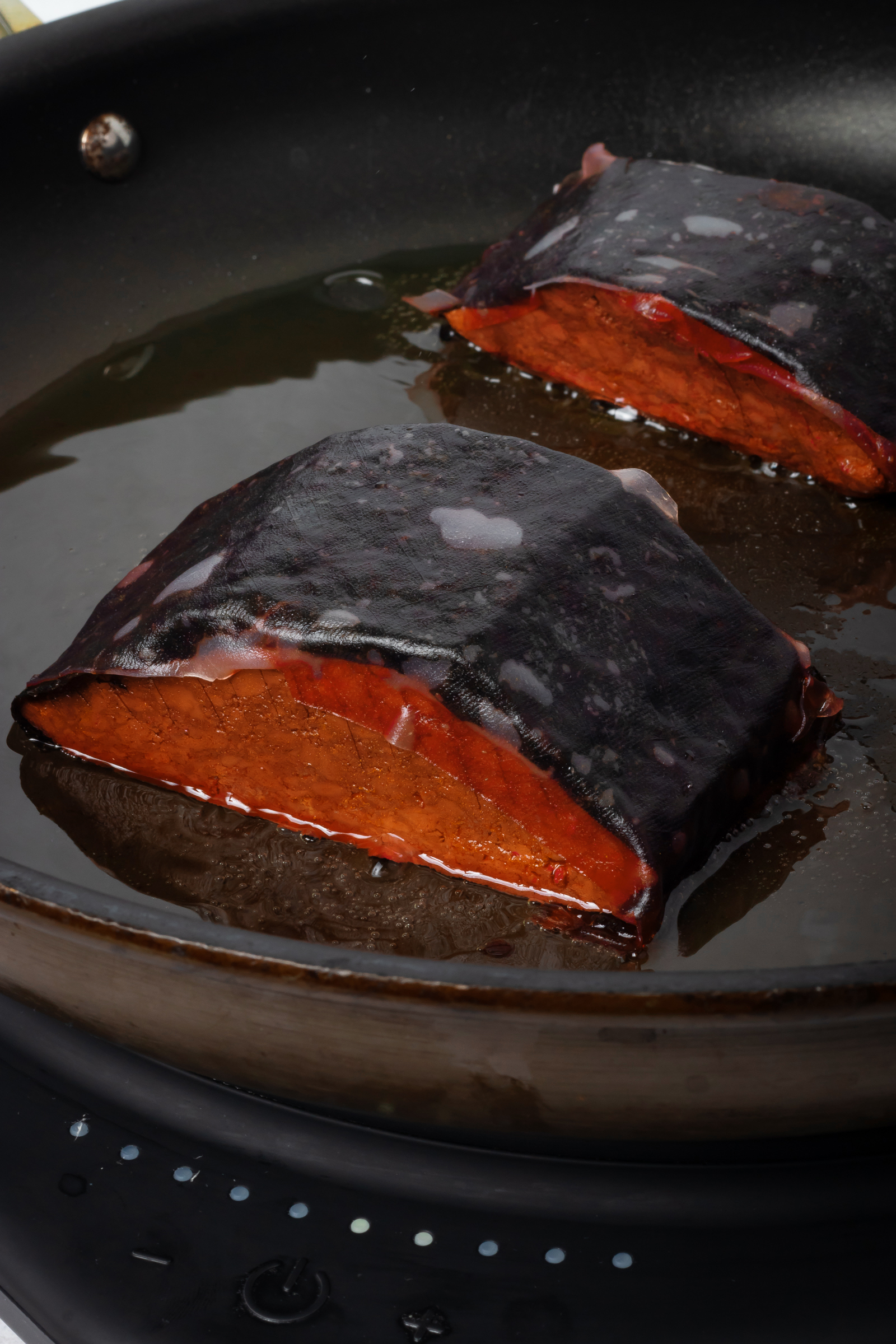
How to Make Vegan Salmon
- Keep in mind this recipe features several ingredients that tend to stain what they touch. I don’t know what your counters are made of, but don’t wear anything you care about and work in a protected area--whether that’s putting everything on a sheet pan to contain any spills, working with gloves, whatever you need.
- In a large glass measuring cup or a bowl that won’t stain (such is glass) (I prefer the measuring cup because it has a spout for easy pouring), measure the beet juice required for the recipe. Add the lemon juice, soy sauce or gluten-free tamari, ground turmeric, smoked paprika and salt. Whisk vigorously until the salt and spices have dissolved. Note that you may see specs of the spices on top of the marinade, but most of it will have mixed in.
- Trim your tofu into filet shapes--this is optional. Don’t round the top too much or it will be hard to sear it evenly. If you don’t want to cut it, just cut the tofu block in half. I like to make thin diagonal cuts across the top (like a hasselback potato) as this helps “flake” the vegan fish after cooking and also looks kinda cool. It also allows the flavor of the marinade to sink deeper into the tofu. Oh and if you did trim the tofu, keep the scraps and use them in tofu scramble, a stir fry like this vegan chop suey, soup like this vegan tom kha, or freeze to use later.
- Pour the marinade into a small glass food storage container (note that food grade plastic will also work but it may stain). Submerge the tofu. It will float to the top but should be almost completely (or completely) covered by the marinade. If you have a very wide or large container, you may need to double the marinade amount to cover the tofu--which is why I recommend a small container. I used a 3-cup rectangular glass food container with a silicone lid.
- Refrigerate for at least 2-4 hours, up to 12 hours. The longer you marinade, the darker the color but the more flavorful the final product--so up to you! The tofu you see in this post was marinated for 8 hours.
- When ready to cook, remove the container from the refrigerator and carefully remove the tofu. It is a bit more delicate when it has been marinating. I like to slide a metal cooking spatula (again metal so it doesn’t stain) under the tofu and move them onto a plate if I plan to pan sear or straight onto a lined baking tray (I use parchment paper) if baking the tofu salmon.
- If you want to add the skin, we’ll do that now. Trim a piece of nori to slightly larger (about ¼ - ½ inch larger on all sides) than your tofu. When you measure it, make sure to curve it against the top of the trimmed filet (if you shaped the tofu like salmon filets) to account for extra length. Now trim your rice paper to the same size. Press the cut nori to the tofu (SHINY SIDE UP/NOT TOUCHING THE TOFU), folding down the edges. It may take a few moments to get the nori sufficiently moistened by the tofu for it to stick. The overlapping edge REALLY helps it stay on during the cooking process (the nori and rice paper will both shrink when cooked). Now wet the rice paper. Submerge it in water until it’s soft enough to move. Shake off the excess water and cover the nori with it, using your finger to press it over the edges of the tofu like you just did with the nori. See video in this post for more visual instruction.
- Pan searing method: Heat a neutral high heat oil (such as grapeseed or avocado oil) in a large nonstick skillet over medium high heat until very hot. You can test this by placing the tip of a toothpick or wooden skewer in the oil--if little bubbles start to form around the wood, the oil is ready. You don’t need much oil but you need enough to cover the surface of the pan. Add the tofu salmon to the oil and pan sear the bottom side first. Cook for about 2-3 minutes until the tofu is nice and browned on the bottom. Cook 2-3 more minutes on each side of the fish, leaving the skin side for last. Carefully flip the tofu onto it’s back (the skin side) and use your spatula to hold each side of the curve against the hot oil in the pan for about 2 minutes. If the skin does start to come off, just flip it onto its side and use cooking implements or a pair of tweezers or small tongs to fix it. Remove from heat and place on the plate to serve immediately.
- Baking method: Regarding the skin, I tried to add it for the baking method and it didn’t wow me but of course you’re welcome to try (follow the “skin” steps above”. Place the tofu on a parchment lined baking tray and bake in a 400 degrees Fahrenheit (205 degrees Celsius) oven for 20-30 minutes, rotating the tray halfway through. Serve immediately.
- Enjoy the vegan salmon immediately. I like to serve with vegan roasted potatoes and some roasted asparagus, green beans, broccoli, or even brussels sprouts. Check out this tutorial on how to air fry frozen brussels sprouts (or fresh!) if you’re interested. As for other ways to serve this “salmon” - you could serve it on top of a salad, broken up into pasta (or just alongside), as the protein in my vegan paella, etc.
- Refrigerate leftovers for 3-4 days in an airtight container. If you added a “skin” I recommend pan searing to reheat leftovers, otherwise the microwave of your favorite reheat method will be fine.
More Vegan Seafood Recipes
- Vegan Scallops with Pasta
- Vegan Fish Tacos
- Chickpea Based Vegan Tuna Melts
- And Vegan Tuna Casserole
- Vegan Paella
- Vegan Lobster Roll
- And more coming.
If you’re looking for a vegan smoked salmon or lox, I have that recipe available exclusively in my Plant Based Jewish Recipes e-book along with 50 other awesome recipes.
Love tofu? Try one of my many other tofu recipes.
Anything Else?
I hope you love this recipe as much as I do. Mr. Zardyplants loves it too. It’s so nostalgic for me to be able to make these recipes that taste so similar to what my mom served growing up.
This vegan salmon is:
- Tender and flaky
- Moist (sorry)
- Flavorful
- Fun
- Satisfying
- Wholesome
- Protein-packed
And perfect for a date night or dinner party, but easy enough to make any night of the week you’re feeling fancy. Grab a wine glass and drink wine (or juice) with your pinky out.
Let me know in the comments below if you make this recipe or tag me @Zardyplants on Instagram so I can see your beautiful recreations! If you tag me on IG, I will share your post in my stories :)
Also, one quick request: if you love how this recipe looks or tastes, please leave me a 5-star rating and a nice comment–ratings help more people find my recipes which helps me keep providing them! Thank you!
<3 Liz
Save this for later on Pinterest!
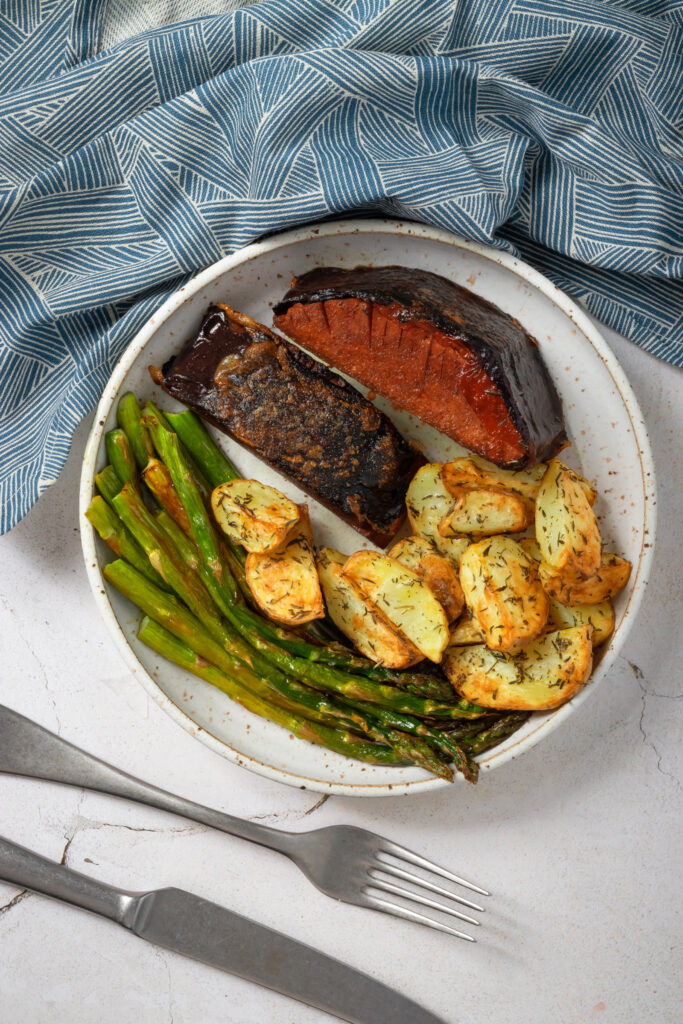

Vegan Salmon
- Total Time: 4 hours, 15 minutes
- Yield: 2 filets 1x
- Diet: Vegan
Description
Delicious and filling, this Vegan Salmon is easy to make in two ways: bake it for an easy meal or pan sear it and enjoy a crispy skin on top.
Ingredients
Tofu Salmon
- 1 ¼ cups beet juice (see note 1)
- ¼ cup lemon juice (juice of about 2 small lemons)
- 2 tablespoons reduced sodium soy sauce or gluten-free tamari
- 1 teaspoon ground turmeric
- 1 teaspoon smoked paprika
- 1 teaspoon iodized salt (see note 2)
- 16 ounce (454 grams) block Super Firm Tofu (vacuum sealed) (see note 3)
Optional “Skin” (see note 4)
- 1 sheet nori seaweed
- 1 sheet rice paper spring roll wrapper
Instructions
- Note: Keep in mind this recipe features several ingredients that tend to stain what they touch. I don’t know what your counters are made of, but don’t wear anything you care about and work in a protected area--whether that’s putting everything on a sheet pan to contain any spills, working with gloves, whatever you need.
- Make marinade: In a large glass measuring cup or a bowl that won’t stain (such is glass) (I prefer the measuring cup because it has a spout for easy pouring), measure the beet juice required for the recipe. Add the lemon juice, soy sauce or gluten-free tamari, ground turmeric, smoked paprika and salt. Whisk vigorously until the salt and spices have dissolved. Note that you may see specs of the spices on top of the marinade, but most of it will have mixed in.
- Cut tofu: Trim your tofu into filet shapes--this is optional. Don’t round the top too much or it will be hard to sear it evenly. If you don’t want to cut it, just cut the tofu block in half. I like to make thin diagonal cuts across the top (like a hasselback potato) as this helps “flake” the vegan fish after cooking and also looks kinda cool. It also allows the flavor of the marinade to sink deeper into the tofu. Oh and if you did trim the tofu, keep the scraps and use them in tofu scramble, a stir fry like this vegan chop suey, soup like this vegan tom kha, or freeze to use later.
- Add to container: Pour the marinade into a small glass food storage container (note that food grade plastic will also work but it may stain). Submerge the tofu. It will float to the top but should be almost completely (or completely) covered by the marinade. If you have a very wide or large container, you may need to double the marinade amount to cover the tofu--which is why I recommend a small container. I used a 3-cup rectangular glass food container with a silicone lid.
- Marinate: Refrigerate for at least 2-4 hours, up to 12 hours. The longer you marinade, the darker the color but the more flavorful the final product--so up to you! The tofu you see in this post was marinated for 8 hours.
- Remove from container: When ready to cook, remove the container from the refrigerator and carefully remove the tofu. It is a bit more delicate when it has been marinating. I like to slide a metal cooking spatula (again metal so it doesn’t stain) under the tofu and move them onto a plate if I plan to pan sear or straight onto a lined baking tray (I use parchment paper) if baking the tofu salmon.
- Optional “skin” instructions: If you want to add the skin, we’ll do that now. Trim a piece of nori to slightly larger (about ¼ - ½ inch larger on all sides) than your tofu. When you measure it, make sure to curve it against the top of the trimmed filet (if you shaped the tofu like salmon filets) to account for extra length. Now trim your rice paper to the same size. Press the cut nori to the tofu (SHINY SIDE UP/NOT TOUCHING THE TOFU), folding down the edges. It may take a few moments to get the nori sufficiently moistened by the tofu for it to stick. The overlapping edge REALLY helps it stay on during the cooking process (the nori and rice paper will both shrink when cooked). Now wet the rice paper. Submerge it in water until it’s soft enough to move. Shake off the excess water and cover the nori with it, using your finger to press it over the edges of the tofu like you just did with the nori. See video in this post for more visual instruction.
- Pan searing method: Heat a neutral high heat oil (such as grapeseed or avocado oil) in a large nonstick skillet over medium high heat until very hot. You can test this by placing the tip of a toothpick or wooden skewer in the oil--if little bubbles start to form around the wood, the oil is ready. You don’t need much oil but you need enough to cover the surface of the pan. Add the tofu salmon to the oil and pan sear the bottom side first. Cook for about 2-3 minutes until the tofu is nice and browned on the bottom. Cook 2-3 more minutes on each side of the fish, leaving the skin side for last. Carefully flip the tofu onto it’s back (the skin side) and use your spatula to hold each side of the curve against the hot oil in the pan for about 2 minutes. If the skin does start to come off, just flip it onto its side and use cooking implements or a pair of tweezers or small tongs to fix it. Remove from heat and place on the plate to serve immediately.
- Baking method: Regarding the skin, I tried to add it for the baking method and it didn’t wow me but of course you’re welcome to try (follow the “skin” steps above”. Place the tofu on a parchment lined baking tray and bake in a 400 degrees Fahrenheit (205 degrees Celsius) oven for 20-30 minutes, rotating the tray halfway through. Serve immediately.
- Serve: Enjoy the vegan salmon immediately. I like to serve with vegan roasted potatoes and some roasted asparagus, green beans, broccoli, or even brussels sprouts. Check out this tutorial on how to air fry frozen brussels sprouts (or fresh!) if you’re interested. As for other ways to serve this “salmon” - you could serve it on top of a salad, broken up into pasta (or just alongside), as the protein in my vegan paella, etc.
- Store: Refrigerate leftovers for 3-4 days in an airtight container. If you added a “skin” I recommend pan searing to reheat leftovers, otherwise the microwave of your favorite reheat method will be fine.
Notes
- Note 1: Don’t worry if you don’t like beets! I hate them and I couldn’t even taste them in this recipe. I do feel like the beet juice does help a bit with the flavor of the vegan salmon, but the main purpose of it is to color the tofu--and it does kind of make the salmon neon pink, yeah. If you can’t find beet juice, you could try unsweetened pomegranate juice, or simply use vegetable broth if you don’t care about the color. You could also try vegan food coloring. You can experiment with watering down the marinade to lighten the salmon, but when I tried it, the flavor wasn’t as delicious so I left it vibrant albeit unrealistic in appearance.
- Note 2: I recommend a finer grain salt like iodized salt in this recipe because we want it to dissolve quickly and evenly in the marinade.
- Note 3: Use “super firm tofu,” or tofu that comes in a vacuum sealed pack (as opposed to tofu that comes submerged in a plastic tub of water). IF all you can get your hands on is extra firm or regular firm tofu in a tub of water, you’ll want to press the tofu for around 30-40 minutes in a tofu press or wrapped in paper towels between two cutting boards or plates and a heavy weight. If you have to buy tofu like that and press it, you may only be able to get one “filet” out of each block since pressing it does make the block thinner.
- Note 4: This is only if you want to add a “skin” to the top of your vegan salmon, which I only recommend if you’re pan searing it. I tried to do it for the baking method and it didn’t wow me but of course you’re welcome to try.
- Prep Time: 5 minutes
- Inactive Time: 4 Hours
- Cook Time: 10 minutes
- Category: Entree
- Method: Stove top
- Cuisine: American, Seafood
Keywords: Vegan fish, vegan salmon, tofu salmon


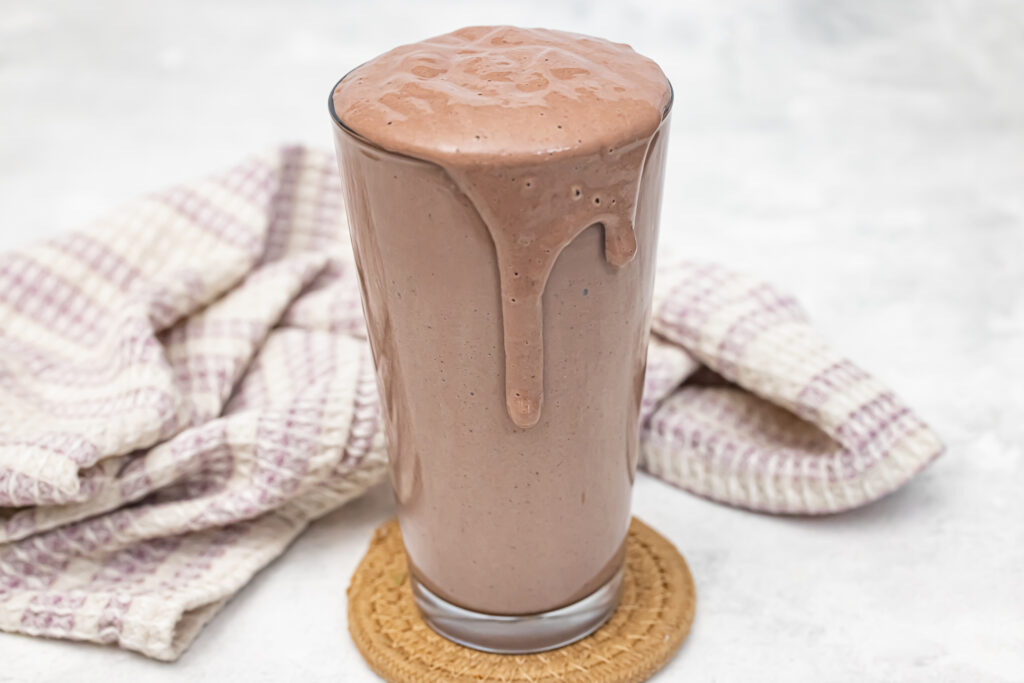
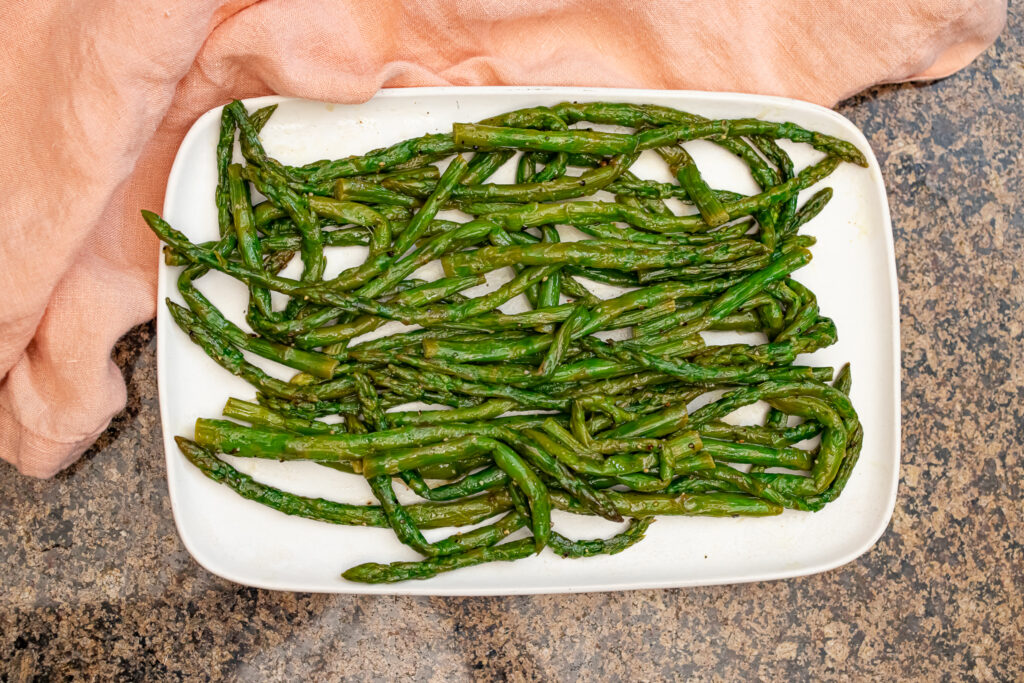
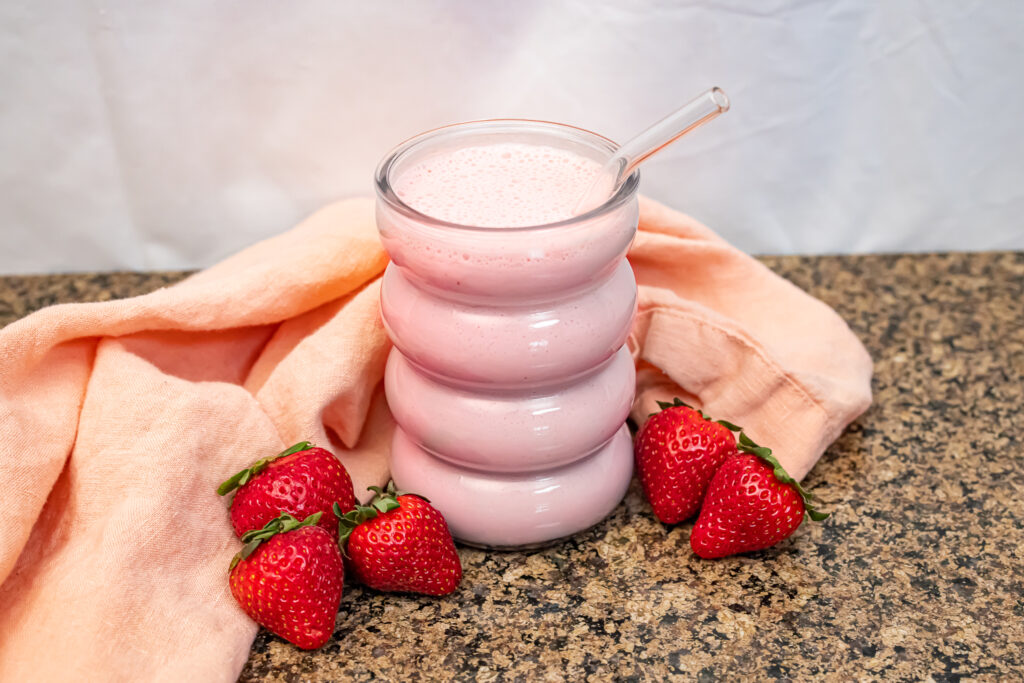
Leave a Reply